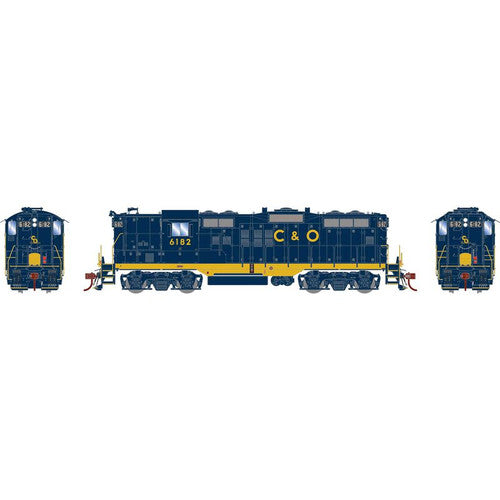Discover the Athearn ATHG82370 GP9 locomotive in HO scale, representing the Chesapeake & Ohio (C&O) #6182. This model comes equipped with DCC and the Sound Tsunami system for an immersive experience.
### C&O Features
- A bell on the short hood
- A forward 5-chime horn
- Dynamic brakes
- Tall exhaust covers
- Professionally approved artwork
Between 1955 and 1957, C&O bought 363 GP9s, which were the fleet's mainstay for both road trains and local service. In the mid-60s, C&O adopted a new simple paint scheme with large C&O initials on the long hood. Many GP9s were displaced to secondary service by newer high-horsepower units but most lasted until the mid-80s. This release benefits a wide range of modelers as these road numbers were in use until then.
### Road Number Specific Features
- **#682 and #683**: Snowplows at both ends, non-dynamic, bell in the center of the long hood.
- **#688 and #690**: Dynamic brakes, bell on the long hood.
### GP9 Series Locomotive Features
- A detailed full cab interior
- Wire grab irons
- Coupler cut levers
- See-through cab windows
- Flexible rubber trainline and MU hoses
- Drop steps (unless noted)
- “Nub” style walkway tread
- Lift rings, sander lines, windshield wipers, and MU stands
- Bell placement and type as per the prototype
- Etched metal radiator intake and fan grilles
- Air tanks below the sill (unless noted)
- Blomberg-B trucks with proper bearing caps
- Speed recorder (unless noted)
- Body-mounted McHenry® operating scale knuckle couplers
- DCC-ready with Quick Plug™ and 21-pin NEM connector
- Fine-scale Celcon handrails for a realistic look
- A detailed fuel tank with fillers, gauges, breather pipes, and retention tanks
- A Genesis driveline with a 5-pole skew wound motor, precision flywheels, and multi-link drivetrain
- All-wheel drive with precision gears for smooth and quiet operation
- All-wheel electrical pickup for reliable current flow
- Wheels with RP25 contours for use on all popular track brands
- Bidirectional constant LED lighting for consistent headlight brightness
- A heavy die-cast frame for better traction and pulling power
- Scaled from prototype resources like drawings, measurements, and photos
- Accurately painted and printed paint schemes
- Fully assembled and ready to run
- Secure packaging for safe storage
- Minimum radius: 18” — Recommended radius: 22”
### Sound-Equipped Models
- An onboard DCC decoder with SoundTraxx Tsunami2 sound
- Dual cube speakers for great sound quality
- Sound units work in both DC and DCC
- Full DCC functions in DCC mode
- Engine, horn, and bell sounds work in DC
- All functions are NMRA compatible in DCC mode
- Precision slow speed control
- Program multiple unit (MU) lashups with lead unit-only horn, bell, and lights
- Many functions can be changed via Configuration Value (CV) adjustments, with a CV chart in the box.
### Prototype Information
In 1949, EMD introduced the GP7, with a short hood and full-height hoods. In 1954, it was upgraded to the 1,750-horsepower GP9. Later versions had different louver arrangements and some lacked frame skirting. Many railroads rebuilt their GP7s and GP9s instead of buying new locomotives.

Using your Athearn GP9 locomotive is easy. First, make sure your track is clean and properly connected. If you're using DC power, simply connect the power pack to the track and switch it on. The engine, horn, and bell sounds will work right away. For DCC operation, connect your DCC system to the track and program the locomotive using the Quick Plug™ and 21 - pin NEM connector. You can use the CV chart in the box to adjust functions like speed and sound.
When it comes to running your train, remember the minimum radius of 18 inches, but a 22 - inch radius is recommended for smoother operation. You can also program multiple locomotives in a lashup, with the lead unit controlling the horn, bell, and lights.
For maintenance, keep the locomotive clean. Use a soft brush to remove dust from the body, wheels, and electrical pickups. Check the couplers regularly to ensure they're working properly. If the sound quality seems off, make sure the dual cube speakers are clean and not blocked. Store the locomotive in its secure packaging when not in use to protect it from damage.









